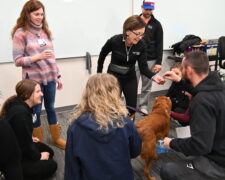Educating future healthcare workers while managing a pandemic
 Faculty and staff were forced into a new way of working in March when the safer-at-home order was enacted by Gov. Tony Evers. With Bellin College being deemed an essential business, employees were able to access the building to facilitate working from home and conducting online courses.
Faculty and staff were forced into a new way of working in March when the safer-at-home order was enacted by Gov. Tony Evers. With Bellin College being deemed an essential business, employees were able to access the building to facilitate working from home and conducting online courses.
All spring events at the college were canceled due to COVID-19, including all outside recruiting and events, staff development day, Campus Preview Day and all Hands On Healthcare events on campus and mobile events.
Faculty who were used to teaching classes face-to-face had to transition to holding classes virtually and also juggling their own family’s needs.
The nursing instructors had some unique challenges when scheduling virtual classes.
“When the decision was made for classes to be put online, many students, since they are nursing students, scheduled themselves to work to help with the COVID-19 pandemic,” said Heidi Monroe, assistant professor of nursing. “This made it difficult to schedule “live” online classes. To handle this situation, I had emailed all the students in my courses two dates that I expected them to attend a ‘live’ class. The dates and times were those when we would have had class.”
Often, just the challenge of moving instruction online was a challenge.
“The biggest impacts of the COVID-19 has been adapting the course work to an online format, staying connected with the students, finding ways to supplement clinical content and trying to juggle work, helping my kids with their virtual learning, and family life,” said Andra Sartorelli, radiologic sciences instructor and clinical coordinator. “My new office is either on the kitchen table or in the basement area as my husband is also working from home and has a lot of conferences calls,” Sartorelli said. “I guess in the grand scheme of things, it is a small price to pay to stay healthy.”
Students in the diagnostic medical sonography program were unable to come to campus to use the scanning equipment, which is a huge way for them to learn and be comfortable with the equipment and scanning a human body.
“Our students will be making up the clinical hours in the summer semester,” said Amanda Hogan, diagnostic medical sonography program director and instructor. “All lectures are held live online for my classes and recorded for Stacey May’s.”
Adapting and learning new techniques was also something instructors faced and led to some different participants in class.
“It forced me to learn how to use Canvas conferences and to come up with some creative ways to conduct class,” Monroe said. “Students really seemed to like the live online class and commented that they preferred it to just watching prerecorded lectures. Also, several students who didn’t typically answer questions in the face-to-face class did answer questions online either verbally or via the chat option.”
“I have been using video conferences with the students to try to stay connected as email is not always the best method of communication. Thank goodness for technology,” Sartorelli said.
There has also been some positives to come out of the pandemic changes.
“One of the biggest positives is that everyone is now aware of, is not taking face-to-face time for granted or the technology that is available to use at the college,” Hogan said. “We have so many wonderful resources in the sonography lab that we take for granted every day. I look forward to the days I can talk in the hallways and see everyone’s smiling faces.”


